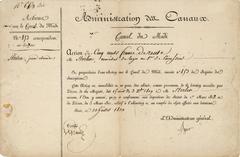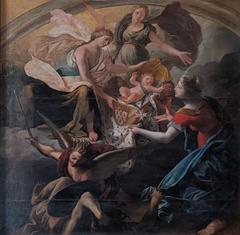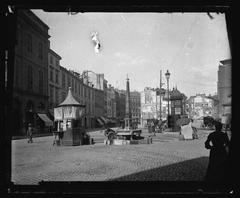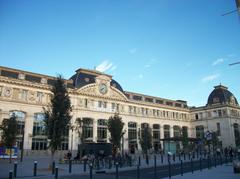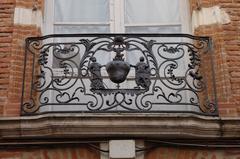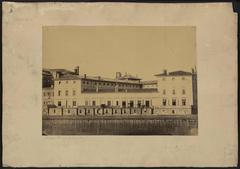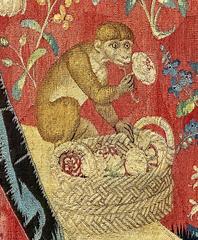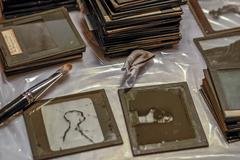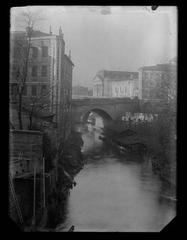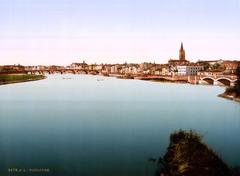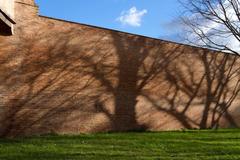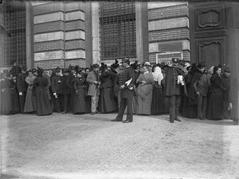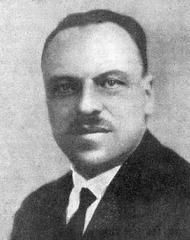
Hôtel De Caulet-Resseguier Toulouse: Visiting Hours, Tickets, and Historical Sites Guide
Publication Date: 03/07/2025
Introduction
Nestled in the historic heart of Toulouse, France, the Hôtel De Caulet-Resseguier stands as a remarkable testament to the city’s Renaissance heritage and architectural grandeur. Also known as Hôtel Duranti, this hôtel particulier was initially commissioned in the early 17th century by Jean-Etienne Duranti and later remodeled by the Caulet and Resseguier families. The mansion reflects the evolving tastes of Toulouse’s elite, particularly during the city’s prosperous pastel (woad) trade era. Its iconic pink brick façade, spiral towers, and intricately sculpted stonework embody the fusion of local craftsmanship and Italian Renaissance influences. Although it remains a private residence, the mansion periodically opens to the public during special events, offering rare access to its artistic and historic interiors.
This guide provides a detailed exploration of the Hôtel De Caulet-Resseguier’s history, architecture, cultural context, and practical visitor information—including visiting hours, ticketing, accessibility, and nearby attractions. Whether you are a history enthusiast, architecture lover, or traveler eager to experience Toulouse’s vibrant past, this resource will help you plan your visit. For the most current details, consult the Toulouse Tourist Office and other official portals. The Audiala app also provides personalized travel guides and real-time updates for sites like Hôtel De Caulet-Resseguier (France-Voyage; Toulouse Tourism; Monumentum).
Historical Background and Architectural Evolution
Origins and Early Development
Hôtel De Caulet-Resseguier, located at 3 rue du Lieutenant-Colonel-Pélissier, exemplifies Toulouse’s Renaissance urban architecture. Commissioned by Jean-Etienne Duranti, the first president of the Parliament of Toulouse, the mansion’s ambitious U-shaped plan set a precedent for grand residences in the city (France-Voyage; Monumentum). The property’s evolution reflects the prosperity of Toulouse’s elite, driven by the flourishing pastel dye trade.
Renovations and Ownership
Duranti and Caulet Families: The mansion saw major updates under Jean-Georges de Caulet, Trésorier Général de France, who introduced modernizations in line with the changing tastes of the 17th-century French nobility.
Resseguier Family and 18th-Century Transformations: The Resseguier family’s 18th-century renovations added decorative elements and refined the interiors, maintaining the hôtel’s prestige and adapting it to Enlightenment-era styles.
Architectural Features
Façade and Layout
Hôtel De Caulet-Resseguier is distinguished by its U-shaped plan, red brick construction, and two spiral towers with slate roofs. The street-facing façade and the lower section of the central staircase have been protected as Monuments Historiques since 1961 (Monumentum; POP Culture Gouv). The mansion’s harmonious blend of pink brick and pale limestone frames, along with sculpted mascarons and family crests, defines its Renaissance character.
Courtyard and Interior
A hallmark of Toulouse’s hôtels particuliers is the tranquil inner courtyard, often featuring arcades supported by classical columns. Inside, the grand staircase serves as both a functional centerpiece and a showcase of elaborate carving and painted decoration. Reception rooms on the piano nobile (first floor) were historically adorned with high ceilings, ornate fireplaces, and decorative ceilings—some original features still survive.
Notable Artistic Elements
Sculpted doorways, window surrounds, mascarons, garlands, putti, and mythological figures are recurring decorative motifs. Surviving interiors may include painted ceilings, carved woodwork, and monumental stone fireplaces (Guide Toulouse Pyrénées).
19th and 20th Century Changes
Urban Development
During the 19th and early 20th centuries, parts of the property were sold and gardens removed to accommodate urban expansion and new commercial needs (France-Voyage).
Galeries Lafayette Acquisition
In the 1960s, the site was acquired by Galeries Lafayette, who preserved key architectural elements while developing a retail complex. The 1962 construction of the Nouvelles Galeries replaced the original garden and some hotel sections (Journées du Patrimoine).
Heritage Protection and Documentation
Hôtel De Caulet-Resseguier is officially listed as a Monument Historique, ensuring the preservation of its façade, roof, and staircase. Extensive archival records and historic photographs are maintained at the Archives départementales de la Haute-Garonne (FranceArchives).
Cultural Significance
Civic Identity and “La Ville Rose”
The mansion is emblematic of Toulouse’s civic pride and the city’s identity as “La Ville Rose.” Its architecture showcases the adaptation of Italian Renaissance forms to local materials and traditions, contributing to the city’s distinctive urban landscape (Condé Nast Traveller).
Influence and Legacy
The design and decorative vocabulary of Hôtel De Caulet-Resseguier influenced subsequent hôtels particuliers in Toulouse and southwestern France. Its blend of Renaissance motifs and regional craftsmanship set a standard for urban residences in the area.
Practical Visitor Information
Location and Accessibility
- Address: 3 rue du Lieutenant-Colonel-Pélissier, Toulouse
- Public Transport: Nearest metro stations are Capitole (Line A) and Esquirol; multiple bus lines serve the city center.
- Parking: Limited in the city center. Walking or public transport is advised.
- Accessibility: Due to its historic nature, accessibility inside may be limited. Exterior viewing is possible at any time. Contact the Toulouse Tourist Office for assistance.
Visiting Hours and Tickets
- General Access: The mansion is primarily a private residence and not open for daily visits. Public access is generally limited to special events such as European Heritage Days (Journées du Patrimoine), usually in September.
- Admission: Entry during these events is typically free. For special guided tours, consult the Toulouse Tourist Office for ticket details.
- Guided Tours: Available during special events or by reservation through the tourist office. Tours are offered in French and English; booking ahead is recommended.
Facilities
- No on-site cafés or restrooms; the surrounding city center offers ample dining and shopping options.
Travel Tips
- Plan visits during European Heritage Days for interior access.
- Comfortable shoes are recommended for cobbled streets and staircases.
- Photography is generally allowed outside; ask for permission for interior photos.
Nearby Attractions
- Place du Capitole: Toulouse’s central square.
- Basilique Saint-Sernin: UNESCO World Heritage Site.
- Jacobins Convent: Gothic architectural masterpiece.
- Garonne Riverbanks: Picturesque walks, especially at sunset.
- Victor Hugo Market: Sample local cuisine and specialties.
The Toulouse City Card provides discounts and free transport for many attractions (Toulouse Tourisme).
FAQ
Q: What are the visiting hours of Hôtel De Caulet-Resseguier?
A: Visiting hours are limited, mainly during special events or guided tours. Refer to the Toulouse Tourist Office for current information.
Q: Is there an admission fee?
A: Usually free during public events; guided tours may require a nominal fee.
Q: Can tickets be bought online?
A: Yes, through the Toulouse Tourist Office.
Q: Is the site accessible for people with reduced mobility?
A: Accessibility is limited; contact the tourist office for assistance.
Q: Can I take photos inside?
A: Exterior photography is generally allowed; interior photography is subject to restrictions.
Visuals and Media
Enhance your visit by exploring high-quality images and virtual tours available on official tourism sites. Recommended alt tags:
- “Hôtel De Caulet-Resseguier pink brick façade Toulouse”
- “Inner courtyard Hôtel De Caulet-Resseguier with arcades”
- “Renaissance sculpted doorway and mascarons Hôtel De Caulet-Resseguier”
- “Ornate painted ceiling inside Hôtel De Caulet-Resseguier”
Sustainable and Respectful Tourism
Support the preservation of Hôtel De Caulet-Resseguier by following guidelines, not touching historic surfaces, and disposing of litter responsibly. Supporting local businesses and guided tours also aids heritage conservation.
Conclusion
The Hôtel De Caulet-Resseguier encapsulates Toulouse’s Renaissance charm and historical significance. While interior access is rare, the mansion’s striking exterior, rich history, and central location make it a must-see for visitors. To maximize your experience, check current visiting hours, book guided tours through the Toulouse Tourist Office, and explore nearby landmarks. Download the Audiala app for personalized guides and stay connected with official tourism resources for the latest updates.






